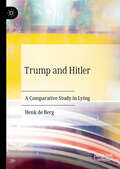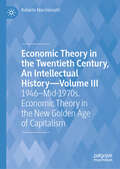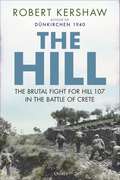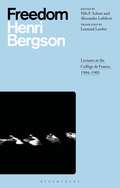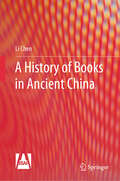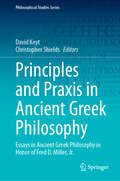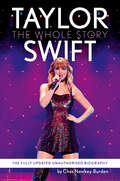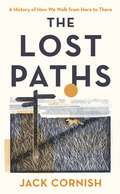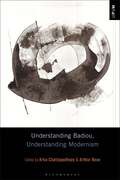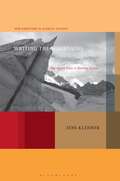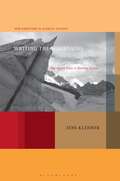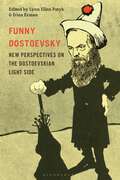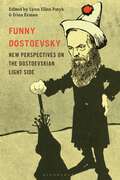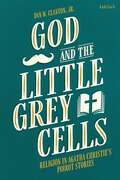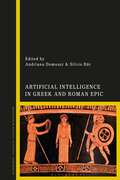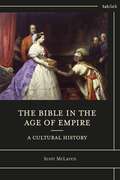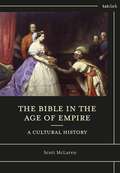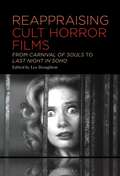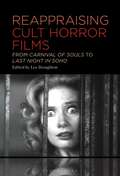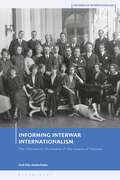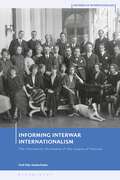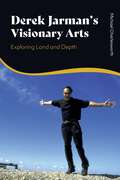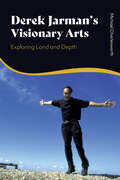- Table View
- List View
Trump and Hitler: A Comparative Study in Lying
by Henk de BergThis book compares Trump and Hitler as political performance artists. It explores their populist self-staging and rhetorical strategies and explains how they connected with their respective audiences. It also analyses the two men’s character, work ethic, and management style. In addition, the book addresses seemingly peripheral issues like the reasons behind Hitler’s toothbrush moustache and Trump’s hairstyle. By demystifying Hitler and Trump, the author throws new light on both of them.
Economic Theory in the Twentieth Century, An Intellectual History—Volume III: 1946–Mid-1970s. Economic Theory in the New Golden Age of Capitalism
by Roberto MarchionattiThis book, set out over four-volumes, provides a comprehensive history of economic thought in the 20th century. Special attention is given to the cultural and historical background behind the development of economic theories, the leading or the peripheral research communities and their interactions, and a critical appreciation and assessment of economic theories throughout these times.Volume III addresses economic theory in the period of the new golden age of capitalism, between the years from the end of the Second World War to the mid1970s, which saw the establishment of the new mainstream, in particular in its Harvard-MIT-Cowles version. It was the period of the pre-eminence of the Neoclassical Keynesian Synthesis—the theoretical core of the period’s dominant school of thought.This work provides a significant and original contribution to the history of economic thought and gives insight to the thinking of some of themajor international figures in economics. It will appeal to students, scholars and the more informed reader wishing to further their understanding of the history of the discipline.
The Hill: The brutal fight for Hill 107 in the Battle of Crete
by Robert KershawFrom the critically acclaimed author of Dünkirchen 1940, this is a groundbreaking history of the epic three-day battle for Hill 107 that changed the course of the war in the Mediterranean. In this remarkable history, we discover each of the individuals whose actions determined the outcome of the battle for Hill 107, the key event that decided the campaign to capture the vitally strategic island of Crete in May 1941. All the events are narrated through the filter of these eyewitnesses. The Allied perspective is from the summit of Hill 107. We experience the fear and the adrenalin of a lowly platoon commander, Lieutenant Ed McAra, perilously positioned at the top of the hill, alongside the combat stress and command fatigue of the battalion commander, Lieutenant Colonel Leslie Andew. In contrast, the German view is looking up from below as they cling to the slopes while simultaneous dazzled by the morning glare and decimated by defensive fire. We join the regimental doctor, Dr Heinrich Neumann, as he assumes command of one battalion and leads a daring nighttime charge towards the summit. The Hill details what was felt, heard or seen throughout the battle for both attacker and defender. Drawing upon original combat reports, diary entries, letters and interviews, the battle is brought vividly to life. The narrative reads like a Shakespearean tragedy, the soldiers revealing their stories in and around the shadows of Hill 107.
Freedom: Lectures at the Collège de France, 1904–1905
by Henri BergsonFor 15 years, Henri Bergson, the most important French philosopher of the early 20th-century, taught at the Collège de France. Speaking without notes, most of his classes are now lost to history, but records of a handful of courses fortuitously survived thanks to stenographic transcripts. Conveying Bergson's very voice, these extraordinary documents are finally presented here in English.The 1904–1905 lectures are dedicated to the topic of freedom, or as Bergson put it, “the evolution of the problem of freedom.” Building on the philosophy of freedom from his first book, Time and Free Will, he proposes that freedom is not only a fundamental human experience but characteristic of all life as such. By retracing how ancient and modern philosophers have dealt with the delicate question of freedom, Bergson demonstrates the necessity, and also the radically new character, of his own theory of freedom.Bergson's lectures are a feast for many audiences. For philosophers, they give a fuller picture of his thought and contain deep reflections on many core topics in philosophy today, from the nature of time to the difference between brain and mind, the relation between memory and perception, and the vindication of freedom over determinism. For intellectual historians, the lectures are a treasure trove: as a slice of the living thought of a great thinker; as an extended analysis of the natural and human sciences of his day; and as a rich commentary on the history of ancient and modern philosophy. Finally, for cultural historians and literary scholars, the lectures were the cultural capital of Belle Époque France, consumed by elites and a vast educated public. They are also part of an exceedingly rare genre in modern philosophy: spoken, not written, lectures and expressed as a veritable stream of philosophical consciousness that is remarkably structured and analytically lucid.
A History of Books in Ancient China
by Li ChenThis book presents a study of the history of ancient Chinese books, not only highlighting specific aspects of the ontology of book history, such as printing and publishing, but also analyzing the internal and external causes of the development of book undertakings from a macro-perspective. Placing the development of and changes in the history of books in the context of social development, it investigates its interaction with politics, economy, society, education, and religion, especially with the big culture, and constructs a book-centered history of ancient Chinese culture.
Principles and Praxis in Ancient Greek Philosophy: Essays in Ancient Greek Philosophy in Honor of Fred D. Miller, Jr. (Philosophical Studies Series #155)
by David Keyt Christopher ShieldsThis collection of original articles draws from a cross section of distinguished scholars of ancient Greek philosophy. It is focussed primarily on the philosophy of Aristotle but comprises as well studies of the philosophy of Socrates, Plato, and Epicurus. Its authors explore a range of complementary topics in value theory, moral psychology, metaphysics, natural philosophy, political theory, and methodology, highlighting the rich and lasting philosophical contributions of the thinkers investigated. Opening with an engaging intellectual autobiography of its honoree, Fred D. Miller, Jr., the volume offers treatments of Socrates as a citizen; Plato’s attitude towards poetry; Socratic self-knowledge; Plato’s conception of law in his Republic; explorations of reason, goodness, and moral conduct in Plato; Platonic metaphysics; Aristotelian causation; Aristotelian metaphysics and normativity; natural philosophy in Aristotle; Aristotelian logic; political theory and approaches to justice in Aristotle’s Politics; methodological reflections on how best to approach Aristotle’s indefensible ideas; and closes with a reconsideration of Epicurus on death and the art of dying. Altogether, the volume reflects the richness of the ongoing community of philosophical scholars dedicated to reconstructing, assessing, and criticizing the principal philosophers of the ancient world, whose epoch-forming explorations of the key elements of human life—considered socially, politically, psychologically, and metaphysically—remain topics of lively investigation today. It will be of interest to philosophers of many stripes, including those with a primary interest in ancient philosophy but extending as well to those with systematic interests in the themes it explores. This volume will be a valuable addition to all libraries serving communities dedicated to researching and studying the origins of Western philosophy.
Taylor Swift: The Whole Story
by null Chas Newkey-BurdenThe #1 New York Times Bestseller As Taylor releases her 11th album, THE TORTURED POET’S DEPARTMENT, catch up on the full story of Taylor Swift’s stratospheric rise to fame; all any dedicated Swifty needs to know about the pop superstar who’s taking over the world A small-town girl with incredible talent – and the strength and determination to realise her dream – Taylor Swift has gone from America’s sweetheart to global megastar. But how did she get there? And how has she coped with the realities of fame? Fully updated in fascinating detail, Taylor Swift: The Whole Story explores Taylor’s musical evolution and her status as a fearless businesswoman operating on her own terms. From her early beginnings in Pennsylvania to the challenges she faced on the road to success, and from her relationships with Harry Styles, Joe Alwyn and Travis Kelce to her record-breaking Eras tour, this is the unmissable account of Taylor’s journey to world domination.
The Lost Paths: A History of How We Walk From Here To There
by Jack CornishDiscover the rich history of Britain's millennia-old network of pathways, and it will be impossible to take an unremarkable walk again . . .'A rallying cry to reclaim lost routes and preserve this precious resource for future generations' Walk Magazine___________Hundreds of thousands of miles of paths reach into, and connect, communities across England and Wales. But by 2026, 10,000 miles of undiscovered footpaths around Britain stand to be lost.Jack Cornish has dedicated the last five years of his life to walking these forgotten routes. Now, in The Lost Paths, he will show you just how special these forgotten rights of way are, and how embedded each path is in the history of Britain.Footpaths, tracks, country lanes and urban streets illuminate how our ancestors interacted with and shaped their landscapes in the pursuit of commerce, salvation, escape, war, and leisure. Paths are an often-overlooked part of our everyday life and our country's history, crucial to understanding the cultural and environmental history of us, as a nation, in our landscape.This is a celebration of an ancient network and a rallying cry to reclaim what has been lost and preserve it for future generations.
Understanding Badiou, Understanding Modernism (Understanding Philosophy, Understanding Modernism)
by Arka Chattopadhyay and Arthur RoseIn his philosophical project, aesthetic orientation and political leanings, Alain Badiou is a product of, and a leading advocate for, European modernism. From the milieu of May 1968 to the contemporary 'postmodern' ethos, Badiou returns, time and again, to avant-garde modernist texts – aesthetic, political, philosophical and scientific – as inspiration for his response to present situations. Drawing upon disciplines as varied as architecture, cinema, theatre, music, history, mathematics, poetry and philosophy, Understanding Badiou, Understanding Modernism shows how Badiou's contribution to philosophy must be understood within the context of his decades-long conversation with modernist thinking. As with other volumes in the series, Understanding Badiou, Understanding Modernism follows a three part structure. The first section explores Badiou's readings of aesthetic, political and scientific modernities; both introducing his system and pointing to how Badiou offers manifold readings of modernism. The middle portion of the book connects Badiou's thought with the various strands of aesthetic, philosophical, amorous and political modernisms in relation to which it can be extended. The final section is a glossary of key concepts and categories that Badiou uses in his interface with modernism.
Understanding Badiou, Understanding Modernism (Understanding Philosophy, Understanding Modernism)
In his philosophical project, aesthetic orientation and political leanings, Alain Badiou is a product of, and a leading advocate for, European modernism. From the milieu of May 1968 to the contemporary 'postmodern' ethos, Badiou returns, time and again, to avant-garde modernist texts – aesthetic, political, philosophical and scientific – as inspiration for his response to present situations. Drawing upon disciplines as varied as architecture, cinema, theatre, music, history, mathematics, poetry and philosophy, Understanding Badiou, Understanding Modernism shows how Badiou's contribution to philosophy must be understood within the context of his decades-long conversation with modernist thinking. As with other volumes in the series, Understanding Badiou, Understanding Modernism follows a three part structure. The first section explores Badiou's readings of aesthetic, political and scientific modernities; both introducing his system and pointing to how Badiou offers manifold readings of modernism. The middle portion of the book connects Badiou's thought with the various strands of aesthetic, philosophical, amorous and political modernisms in relation to which it can be extended. The final section is a glossary of key concepts and categories that Badiou uses in his interface with modernism.
Writing the Mountains: The Alpine Form in German Fiction (New Directions in German Studies)
by Professor or Dr. Jens KlennerWriting the Mountains reconsiders the role of mountains in German language fiction from 1800 to the present and argues that in a range of texts, from E.T.A. Hoffmann's “Die Bergwerke zu Falun” (1819) to Elfriede Jelinek's Die Kinder der Toten (1995) and beyond, mountains serve as dynamic spaces of material change that generate aesthetic and narrative innovation. In contrast to dominant critical approaches to the Alpine landscape in literature, in which mountain ranges often features as passive settings, or which trace the influence of geographical and geological sciences in literary productions, this study argues for the dynamic role in literature of presumably rigid mineral structures.In German-language fiction after 1800, the counter-intuitive topology of rocky mountain ranges and unfathomable subterranean depths of the Alpine imaginary functions as a space of exception which appears to reconfirm and radically challenge the foundations of Enlightenment thought. Writing the Mountains reads the mountain range as a rigid yet permeable liminal space. Within this zone, semiotic orders are unsettled, as is the division between organic and inorganic, between the human and the other.
Writing the Mountains: The Alpine Form in German Fiction (New Directions in German Studies)
by Professor or Dr. Jens KlennerWriting the Mountains reconsiders the role of mountains in German language fiction from 1800 to the present and argues that in a range of texts, from E.T.A. Hoffmann's “Die Bergwerke zu Falun” (1819) to Elfriede Jelinek's Die Kinder der Toten (1995) and beyond, mountains serve as dynamic spaces of material change that generate aesthetic and narrative innovation. In contrast to dominant critical approaches to the Alpine landscape in literature, in which mountain ranges often features as passive settings, or which trace the influence of geographical and geological sciences in literary productions, this study argues for the dynamic role in literature of presumably rigid mineral structures.In German-language fiction after 1800, the counter-intuitive topology of rocky mountain ranges and unfathomable subterranean depths of the Alpine imaginary functions as a space of exception which appears to reconfirm and radically challenge the foundations of Enlightenment thought. Writing the Mountains reads the mountain range as a rigid yet permeable liminal space. Within this zone, semiotic orders are unsettled, as is the division between organic and inorganic, between the human and the other.
Funny Dostoevsky: New Perspectives on the Dostoevskian Light Side
Tapping into the emergence of scholarly comedy studies since the 2000s, this collection brings new perspectives to bear on the Dostoevskian light side. Funny Dostoevksy demonstrates how and why Dostoevsky is one of the most humorous 19th-century authors, even as he plumbs the depths of the human psyche and the darkest facets of European modernity. The authors go beyond the more traditional categories of humor, such as satire, parody, and the carnivalesque, to apply unique lenses to their readings of Dostoevsky. These include cinematic slapstick and the body in Crime and Punishment, the affective turn and hilarious (and deadly) impatience in Demons, and ontological jokes in Notes from Underground and The Idiot. The authors – (coincidentally?) all women, including some of the most established scholars in the field alongside up-and-comers – address gender and the marginalization of comedy, culminating in a chapter on Dostoevsky's "funny and furious" women, and explore the intersections of gender and humor in literary and culture studies. Funny Dostoevksy applies some of the latest findings on humor and laughter to his writing, while comparative chapters bring Dostoevsky's humor into conjunction with other popular works, such as Chaplin's Modern Times and Lin-Manuel Miranda's Hamilton. Written with a verve and wit that Dostoevsky would appreciate, this boldly original volume illuminates how humor and comedy in his works operate as vehicles of deconstruction, pleasure, play, and transcendence.
Funny Dostoevsky: New Perspectives on the Dostoevskian Light Side
by Lynn Ellen Patyk and Irina ErmanTapping into the emergence of scholarly comedy studies since the 2000s, this collection brings new perspectives to bear on the Dostoevskian light side. Funny Dostoevksy demonstrates how and why Dostoevsky is one of the most humorous 19th-century authors, even as he plumbs the depths of the human psyche and the darkest facets of European modernity. The authors go beyond the more traditional categories of humor, such as satire, parody, and the carnivalesque, to apply unique lenses to their readings of Dostoevsky. These include cinematic slapstick and the body in Crime and Punishment, the affective turn and hilarious (and deadly) impatience in Demons, and ontological jokes in Notes from Underground and The Idiot. The authors – (coincidentally?) all women, including some of the most established scholars in the field alongside up-and-comers – address gender and the marginalization of comedy, culminating in a chapter on Dostoevsky's "funny and furious" women, and explore the intersections of gender and humor in literary and culture studies. Funny Dostoevksy applies some of the latest findings on humor and laughter to his writing, while comparative chapters bring Dostoevsky's humor into conjunction with other popular works, such as Chaplin's Modern Times and Lin-Manuel Miranda's Hamilton. Written with a verve and wit that Dostoevsky would appreciate, this boldly original volume illuminates how humor and comedy in his works operate as vehicles of deconstruction, pleasure, play, and transcendence.
God and the Little Grey Cells: Religion in Agatha Christie's Poirot Stories
by Dan W. Clanton, Jr.Dan W. Clanton, Jr. examines the presence and use of religion and Bible in Agatha Christie's Hercule Poirot novels and stories and their later interpretations. Clanton begins by situating Christie in her literary, historical, and religious contexts by discussing “Golden Age” crime fiction and Christianity in England in the late 19th-early 20th centuries. He then explores the ways in which Bible is used in Christie's Poirot novels as well as how Christie constructs a religious identity for her little Belgian sleuth. Clanton concludes by asking how non-majority religious cultures are treated in the Poirot canon, including a heterodox Christian movement, Spiritualism, Judaism, and Islam. Throughout, Clanton acknowledges that many people do not encounter Poirot in his original literary contexts. That is, far more people have been exposed to Poirot via “mediated” renderings and interpretations of the stories and novels in various other genres, including radio, films, and TV. As such, the book engages the reception of the stories in these various genres, since the process of adapting the original narrative plots involves, at times, meaningful changes. Capitalizing on the immense and enduring popularity of Poirot across multiple genres and the absence of research on the role of religion and Bible in those stories, this book is a necessary contribution to the field of Christie studies and will be welcomed by her fans as well as scholars of religion, popular culture, literature, and media.
Artificial Intelligence in Greek and Roman Epic
by Andriana Domouzi and Silvio BärThis is the first scholarly exploration of concepts and representations of Artificial Intelligence in ancient Greek and Roman epic, including their reception in later literature and culture. Contributors look at how Hesiod, Homer, Apollonius of Rhodes, Moschus, Ovid and Valerius Flaccus crafted the first literary concepts concerned with automata and the quest for artificial life, as well as technological intervention improving human life.Parts one and two consider, respectively, archaic Greek, and Hellenistic and Roman, epics. Contributors explore the representations of Pandora in Hesiod, and Homeric automata such as Hephaestus' wheeled tripods, the Phaeacian king Alcinous' golden and silver guard dogs, and even the Trojan Horse. Later examples cover Artificial Intelligence and automation (including Talos) in the Argonautica of Apollonius and Valerius Flaccus, and Pygmalion's ivory woman in Ovid's Metamorphoses. Part three underlines how these concepts benefit from analysis of the ekphrasis device, within which they often feature. These chapters investigate the cyborg potential of the epic hero and the literary implications of ancient technology. Moving into contemporary examples, the final chapters consider the reception of ancient literary Artificial Intelligence in contemporary film and literature, such as the Czech science-fiction epic Starvoyage, or Small Cosmic Odyssey by Jan Kr?esadlo (1995) and the British science-fiction novel The Holy Machine by Chris Beckett (2004).
Artificial Intelligence in Greek and Roman Epic
This is the first scholarly exploration of concepts and representations of Artificial Intelligence in ancient Greek and Roman epic, including their reception in later literature and culture. Contributors look at how Hesiod, Homer, Apollonius of Rhodes, Moschus, Ovid and Valerius Flaccus crafted the first literary concepts concerned with automata and the quest for artificial life, as well as technological intervention improving human life.Parts one and two consider, respectively, archaic Greek, and Hellenistic and Roman, epics. Contributors explore the representations of Pandora in Hesiod, and Homeric automata such as Hephaestus' wheeled tripods, the Phaeacian king Alcinous' golden and silver guard dogs, and even the Trojan Horse. Later examples cover Artificial Intelligence and automation (including Talos) in the Argonautica of Apollonius and Valerius Flaccus, and Pygmalion's ivory woman in Ovid's Metamorphoses. Part three underlines how these concepts benefit from analysis of the ekphrasis device, within which they often feature. These chapters investigate the cyborg potential of the epic hero and the literary implications of ancient technology. Moving into contemporary examples, the final chapters consider the reception of ancient literary Artificial Intelligence in contemporary film and literature, such as the Czech science-fiction epic Starvoyage, or Small Cosmic Odyssey by Jan Kr?esadlo (1995) and the British science-fiction novel The Holy Machine by Chris Beckett (2004).
The Bible in the Age of Empire: A Cultural History
by Scott McLarenThe nineteenth century was a time of titanic change. At the very heart of that change – driving it, confounding it, complicating it – was a singular book reputed to be utterly unchanging in its true and perfect expression. This book was the Bible. No other book could rival its ubiquity or cultural potency. Neither was any other book quite so divisive. Many revered it. Others deplored it. Still others used it for creative inspiration or borrowed its authority to bring about particular economic or political ends. But whatever status it enjoyed, whatever purpose it served, it was never far from the centre of Victorian discourse. The essays in this book explore how the Bible shaped and was shaped by the social and cultural forces at work during the nineteenth century -- forces that drove both scientific discovery and the colonial project, provoked unprecedented economic gain and condemned countless workers to urban poverty, gave birth to women's rights movements and reinforced traditional gender norms. Ultimately, all the essays in this book demonstrate one thing: that the nineteenth century emerges in its greatest clarity only when we approach it as the Victorians themselves approached it: through the lens of the Bible.
The Bible in the Age of Empire: A Cultural History
The nineteenth century was a time of titanic change. At the very heart of that change – driving it, confounding it, complicating it – was a singular book reputed to be utterly unchanging in its true and perfect expression. This book was the Bible. No other book could rival its ubiquity or cultural potency. Neither was any other book quite so divisive. Many revered it. Others deplored it. Still others used it for creative inspiration or borrowed its authority to bring about particular economic or political ends. But whatever status it enjoyed, whatever purpose it served, it was never far from the centre of Victorian discourse. The essays in this book explore how the Bible shaped and was shaped by the social and cultural forces at work during the nineteenth century -- forces that drove both scientific discovery and the colonial project, provoked unprecedented economic gain and condemned countless workers to urban poverty, gave birth to women's rights movements and reinforced traditional gender norms. Ultimately, all the essays in this book demonstrate one thing: that the nineteenth century emerges in its greatest clarity only when we approach it as the Victorians themselves approached it: through the lens of the Bible.
Reappraising Cult Horror Films: From Carnival of Souls to Last Night in Soho
Identifies key – and in some cases previously overlooked – cult horror films from around the world and reappraises them by approaching and interrogating them in new ways.New productions in the horror genre occupy a prominent space within the cinematic landscape of the 21st century, but the genre's back catalogue of older films refuses to be consigned to the motion picture graveyard just yet. Interest in older horror films remains high, and an ever-increasing number of these films have enjoyed an afterlife as cult movies thanks to regular film festival screenings, television broadcasts and home video releases. Similarly, academic interest in the horror genre has remained high. The frameworks applied by contributors to the collection include genre studies, narrative theory, socio-political readings, aspects of cultural studies, gendered readings, archival research, fan culture work, interviews with filmmakers, aspects of film historiography, spatial theory and cult film theory. Covering a corpus of films that ranges from recognised cult horror classics such as The Wicker Man, The Shining and Candyman to more obscure films like Daughters of Darkness, The Legend of the 7 Golden Vampires, Shivers, Howling III: The Marsupials and Inside, Broughton has curated an international selection of case studies that show the diverse nature of the cult horror subgenre. Be they star-laden, stylish, violent, bizarre or simply little heard-of obscurities, this book offers a multitude of new critical insights into a truly eclectic selection of cult horror films.
Reappraising Cult Horror Films: From Carnival of Souls to Last Night in Soho
by Lee BroughtonIdentifies key – and in some cases previously overlooked – cult horror films from around the world and reappraises them by approaching and interrogating them in new ways.New productions in the horror genre occupy a prominent space within the cinematic landscape of the 21st century, but the genre's back catalogue of older films refuses to be consigned to the motion picture graveyard just yet. Interest in older horror films remains high, and an ever-increasing number of these films have enjoyed an afterlife as cult movies thanks to regular film festival screenings, television broadcasts and home video releases. Similarly, academic interest in the horror genre has remained high. The frameworks applied by contributors to the collection include genre studies, narrative theory, socio-political readings, aspects of cultural studies, gendered readings, archival research, fan culture work, interviews with filmmakers, aspects of film historiography, spatial theory and cult film theory. Covering a corpus of films that ranges from recognised cult horror classics such as The Wicker Man, The Shining and Candyman to more obscure films like Daughters of Darkness, The Legend of the 7 Golden Vampires, Shivers, Howling III: The Marsupials and Inside, Broughton has curated an international selection of case studies that show the diverse nature of the cult horror subgenre. Be they star-laden, stylish, violent, bizarre or simply little heard-of obscurities, this book offers a multitude of new critical insights into a truly eclectic selection of cult horror films.
Informing Interwar Internationalism: The Information Strategies of the League of Nations (Histories of Internationalism)
by Emil Eiby SeidenfadenExamining the public information strategies employed by the League of Nations between 1919 and 1940, this book brings together international history, intellectual history and the history of communications to tell the story of how officials in Geneva planned for a new kind of public relations to underpin and strengthen the League's internationalist project. Drawing on multi-archival work and shedding light on the role played by journalists in international diplomacy, it follows in the footsteps of individuals who left promising careers to work for the League's information section and shape opinion on a global scale. Showcasing their vision for an open diplomacy and an informed international public, Seidenfaden shows how this was sought for and achieved against the politically charged backdrop of interwar Europe. Moving beyond the outbreak of WWII, it also shows the legacies that remained after the League was in hiatus, and many of its officials in exile. In doing so, this book reveals how public information strategies developed by the League were transferred into its successor organisation, the United Nations, which continues to shape our world today.
Informing Interwar Internationalism: The Information Strategies of the League of Nations (Histories of Internationalism)
by Emil Eiby SeidenfadenExamining the public information strategies employed by the League of Nations between 1919 and 1940, this book brings together international history, intellectual history and the history of communications to tell the story of how officials in Geneva planned for a new kind of public relations to underpin and strengthen the League's internationalist project. Drawing on multi-archival work and shedding light on the role played by journalists in international diplomacy, it follows in the footsteps of individuals who left promising careers to work for the League's information section and shape opinion on a global scale. Showcasing their vision for an open diplomacy and an informed international public, Seidenfaden shows how this was sought for and achieved against the politically charged backdrop of interwar Europe. Moving beyond the outbreak of WWII, it also shows the legacies that remained after the League was in hiatus, and many of its officials in exile. In doing so, this book reveals how public information strategies developed by the League were transferred into its successor organisation, the United Nations, which continues to shape our world today.
Derek Jarman’s Visionary Arts: Exploring Land and Depth
by Michael CharlesworthDerek Jarman's place in the history of film is assured by virtue of his vibrant, defiant films that experiment with the very process of film-making and create new forms. His paintings, their excitements and their profundity, are less well known. Michael Charlesworth sheds light on the varied ramifications of Jarman's artistic practice from his years at Prospect Cottage, Dungeness, and provides the first book-length study of his interest in depth psychology. He draws on Jarman's paintings, especially his landscapes from the 1960s and 70s, his multiple series such as 'black' and 'broken glass', GBH, Queer and Evil Queen, and his last Ecstatic Landscapes (1991-3). He also showcases Jarman's excellence as a writer with respect to his memoir, Kicking the Pricks. In a novel approach to Jarman's cinema, selecting films such as Journey to Avebury (1973), Caravaggio (1986), The Garden (1990) and Blue (1993), Charlesworth emphasizes themes and artistry rather than narrative. Exploring the ways in which Jungian and post-Jungian psychology were absorbed into Jarman's varied works, Derek Jarman's Visionary Arts provides a fresh perspective on his painting, film and writing. It celebrates him as one of the major British artists of the late 20th century, engaging with current debates about queer sexualities, environmentalism and climate catastrophe.
Derek Jarman’s Visionary Arts: Exploring Land and Depth
by Michael CharlesworthDerek Jarman's place in the history of film is assured by virtue of his vibrant, defiant films that experiment with the very process of film-making and create new forms. His paintings, their excitements and their profundity, are less well known. Michael Charlesworth sheds light on the varied ramifications of Jarman's artistic practice from his years at Prospect Cottage, Dungeness, and provides the first book-length study of his interest in depth psychology. He draws on Jarman's paintings, especially his landscapes from the 1960s and 70s, his multiple series such as 'black' and 'broken glass', GBH, Queer and Evil Queen, and his last Ecstatic Landscapes (1991-3). He also showcases Jarman's excellence as a writer with respect to his memoir, Kicking the Pricks. In a novel approach to Jarman's cinema, selecting films such as Journey to Avebury (1973), Caravaggio (1986), The Garden (1990) and Blue (1993), Charlesworth emphasizes themes and artistry rather than narrative. Exploring the ways in which Jungian and post-Jungian psychology were absorbed into Jarman's varied works, Derek Jarman's Visionary Arts provides a fresh perspective on his painting, film and writing. It celebrates him as one of the major British artists of the late 20th century, engaging with current debates about queer sexualities, environmentalism and climate catastrophe.
